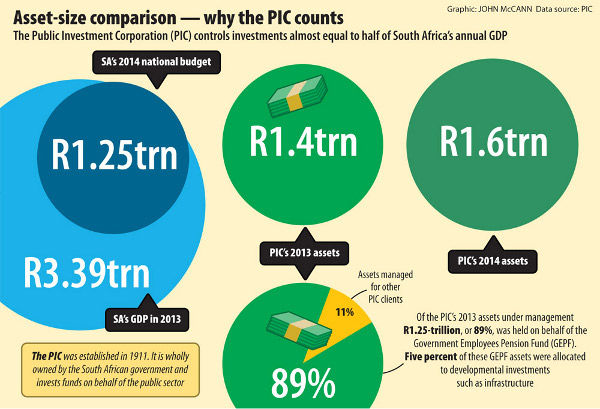Breakdown of trust: Riah Phiyega.
The Public Investment Corporation (PIC) has quietly handed over another R1.5-billion of civil servants’ pension savings to Texas oilman Kase Lawal, despite saying repeatedly that it would hold off until his loss-making company tapped significant new oil in Nigeria, proving its viability.
The second tranche of the PIC’s $270-million (almost R3-billion) investment in Camac Energy was paid on May 6, the day before the national elections.
The PIC’s first tranche in February staved off Camac’s possible liquidation. The state-owned corporation’s decision to risk so much on the Houston-based oil company has reinforced perceptions that it is being guided by political considerations rather than by the interests of public servants, whose pension savings it manages.

Lawal, Camac’s chief executive and largest shareholder, has attracted repeated controversy over his business practices but remains politically connected on both sides of the Atlantic. In South Africa, he has cosied up to the ANC and President Jacob Zuma.
The Business Times reported on Sunday that PIC chief executive Elias Masilela’s sudden, unexplained departure last Friday followed clashes between him and chief investment officer Daniel Matjila, “in particular” over Camac.
Matjila has been the PIC’s point man on the deal and took up a seat on Camac’s board last Thursday to represent the PIC’s now about 30% shareholding.
The Business Times wrote that Matjila and “others regarded as close to … Zuma” had put pressure on Masilela to go. If accurate, this suggests that the latter was not being pliable enough, including over Camac.
Masilela did not return repeated calls and the PIC said it “will not comment on baseless allegations”.
The Mail & Guardian revealed in mid-February how risky the investment was. Camac is a penny stock, with its primary listing on a New York junior exchange.
It has exploration acreage in four African countries but its oil production is only marginal, and it was in so much trouble last September that a regulatory filing admitted “substantial doubt about the company’s ability to continue as a going concern”.
The PIC’s agreement in October to buy 30% of Camac gave it the chance to dig itself out of the hole by putting together a package that included buying the two-fifths it did not yet own of Oyo, its only producing oilfield, and contracting to complete the partly drilled Oyo-7 well in the hope it would augment the field’s 2 000 barrel-a-day trickle. Oyo is off the Nigerain coast.
Camac agreed to put $170-million in cash from the PIC’s investment towards buying the two-fifths oilfield stake. It would be sold by a Nigerian company, owned privately by the Lawal family.
The PIC’s investment remained under water this week. Camac’s $0.61 share price close on Wednesday valued the PIC’s stake at $228-million, or $42-million below what the PIC paid.
The M&G first exposed Lawal in 2003 for appropriating discount Nigerian crude meant to benefit South Africa. He had the help of leading figures in the ANC and a letter then-president Thabo Mbeki had written his Nigerian counterpart. Lawal denied wrongdoing.
Lawal has grown close to Zuma, too, making R1-million annual donations since 2010 to his education trust and accompanying Zuma in 2011 to get an honorary doctorate from his alma mater, the Texas Southern University.
Red flags
Lawal’s closeness to the ruling party and the president and his habit of making political donations – at least in the United States, where they are transparent by law – has raised the question whether the PIC bet on Camac might have been motivated by the ANC’s need for election funding.
The PIC’s precipitous decisions about a risky investment raises red flags. When the PIC signed the share purchase agreement on October 21 last year, it was in the dark on two key points:
The terms of Camac’s purchase of the rest of the Oyo field from the Lawals were not finalised. This means the PIC could not know how much of its investment would stay productively in Camac and how much would flow privately to the Lawals; and
The preliminary drilling of the Oyo-7 well was not yet complete and full results were not known. This means the PIC signed without having the full facts about Camac’s first best hope for profitability.
A week after the M&G’s February article, the PIC released a statement in Masilela’s name, defending the investment. It claimed that the second tranche depended on Camac completing Oyo-7 and it producing over 7 000 barrels a day.
When amaBhungane questioned the PIC claim, as the share purchase agreement reflected no such condition, Matjila repeated the claim.
In March, City Press reported that Matjila had confirmed to it, too, that the PIC “won’t pay the next $135-million until the oil is actually flowing”.
The assurances did not last. No further drilling was done and there was not even the gurgle of oil when the money flowed.
Unlike the first tranche, which Camac trumpeted, neither party made an explicit announcement about it. But Camac’s first-quarter financials, filed with the US Securities and Exchange Commission on May 9, disclosed that the $135-million “second closing” was on May 6.
It also said that Camac had, within two days, paid a second $85-million to the Lawals’ private Nigerian company to complete the $170-million purchase consideration for the Oyo field stake.
Did any of this flow to the ANC?
In February, Camac and Lawal denied having made donations to the ANC, but did not answer whether they might do so in future. Camac this week said it “has never made any donation to any political party anywhere in the world” but did not say anything about Lawal.
ANC spokesperson Keith Khoza said: “If there was a donation, the ANC would know something. If there was a promise, the ANC would know something. But we do not know anything about the allegation.”
Meanwhile, Camac appears to be struggling to dig itself out of the hole. There has been no drilling on Oyo-7 since last year. Camac announced in late April that the Energy Searcher, a drill ship it had contracted, would drill a new Oyo-8 well before completing Oyo-7.
But drilling on Oyo-8, which Camac said was planned for mid-May, has not started and this week the Energy Searcher was still in Lagos harbour, tracking data showed. At best, the first oil, if found, may flow towards the end of the year.
Camac said in response to questions: “Drilling is commencing on Oyo-8 and the company is confident that first production from Oyo-7 and Oyo-8 will be achieved this year, with combined production expected to be around 14 000 barrels a day by year-end.”
What remains of the PIC’s $270-million after $170-million flowed to the Lawals privately – and after more is burnt month after month to cover operating losses – is not enough to sustain the drilling.
Camac went on a road show in January to promote a high-yield bond to raise up to $300-million more. These efforts have yet to show results.
The proposed bond is rated CCC+, which is well below “investment grade”. But if the bond issue is successful, the PIC will stand behind bondholders in the creditors’ queue. This in effect ranks the PIC’s investment as worse than CCC+, illustrating the extent of risk it assumed.
This week, the PIC did not respond to the question about why the second tranche was paid. It said: “Generally exploration companies require some time before they can show some viability and Camac is no exception.
“From an operational perspective, Camac is already producing. Drilling is well underway and drilling of Oyo 7 is complete and now drilling of Oyo 8 is commencing, the combined production of these is expected to be around 14 000 barrels per day by the end of the year.”
But Camac’s own literature states explicitly that the existing production from two earlier Oyo wells is not economically viable – and that only “phase one” drilling was done on Oyo-7 last year, which has to be completed. Oyo-8 drilling has yet to start.
* Got a tip-off for us about this story? Click here.

The M&G Centre for Investigative Journalism (amaBhungane) produced this story. All views are ours. See www.amabhungane.co.za for our stories, activities and funding sources.